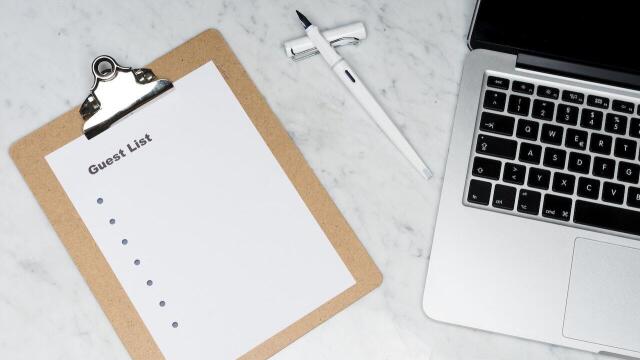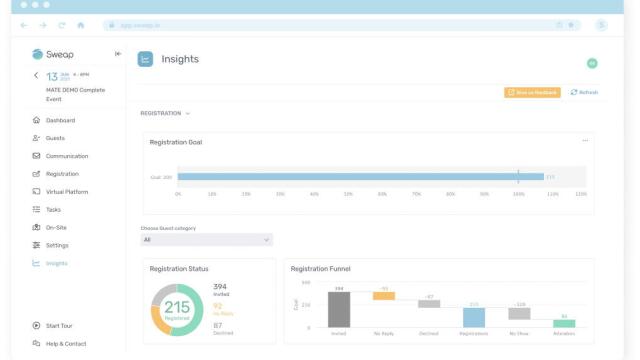
No matter whether it is a symposium, a festive reception or a seminar: every event begins with an invitation. The invitation not only announces the event, but is usually the first time the potential guest interacts with the event. The impression it gives is therefore also the first impression of the event itself. Therefore, a good invitation should not only be inviting, but should also be thought through. This article reveals how this can be achieved and what you should bear in mind when doing so.
The 5 elements of a good invitation
No matter whether you invite by letter or e-mail: You should never forget these points when planning your event invitation.
1. The first impression is essential
What is the very first thing the recipient sees when they receive your invitation? For emails, it is the sender and the subject, for invitations sent by post it is usually an envelope or card.
Whichever you choose: Make sure that this element is designed so that the recipient doesn't even think of not opening the invitation. The subject should be both descriptive and a good reason to open the email - short but to the point. Create a necessity for this ("Don't miss [event]!") or address the recipient personally in the subject ("Mr. [name], come to [event]!").
The sender should appear professional and be clearly identifiable - e.g. the name of your company or your event series - to avoid it ending up in the spam folder. The same applies to letters: Choose a design that looks personal and of high quality and fits the nature of your event. For a festive reception or a film premiere, it may be a high-quality, hand-written envelope; for more casual occasions, a professionally designed card may be sufficient. But no matter what you decide on: Be aware that the design is the first thing the recipient learns about you and your event.
2. Now let’s get personal!
The recipient has opened the invitation - now it's time to convince him or her that the event cannot take place without him or her. The following therefore applies to the form of address: the more personal the better. Anyone who feels like he is just one in a million in the invitation could get the impression that the event itself is no different. Therefore, avoid general phrases like "Dear Ladies and Gentlemen" and instead invite each individual guest with a personal address.
With the right tools this hardly takes longer than an anonymous BCC mail, where a standard invitation is sent to all guests - and it's worth it.
3. Tell me what I want
Normally you have exactly one chance to convince the recipient of your invitation to come to your event: When he reads the invitation for the first time. If he is not convinced or still uncertain afterwards, you probably have no further chance to convince him or her.
So take advantage of the attention you have earned by a great design and addressing the invitee and tell him or her right now why this event is exactly what he has been waiting for. What makes your event special? What awaits him or her there that he cannot get anywhere else? Convince him or her, so that he can't help but accept directly.
By clever choice of words and an extensive and interesting offer you can significantly increase the number of registrations.

Example of an e-mail invitation with Sweap
4. Fact check
Naturally, a few details about the event should also be included in the invitation. To make sure you don't forget anything, it's best to follow the five big questions:
What is taking place?
When does it take place?
Where does it take place?
Who is speaking, performing or participating?
How can you register?
This is information your guests shouldn't have to search for - so place it clearly and logically so that they can't be overlooked.
5. And now?
To make sure the invitation doesn't disappear in some drawer or in the depths of the email inbox after the first reading, and therefore also out of the recipient's mind, you should tell him or her how he should react to the invitation. Should he/she call you? Register via a registration page? Send a letter back? The rule is simple: The easier it is to react, the higher the probability for an immediate response.
And this is exactly what you want: yes or no, accept or reject, before the whole event is forgotten. So set the threshold as low as possible, for example by enclosing a pre-franked card with the invitation, on which the recipient only has to tick whether he or she is coming, or - even easier - by setting up a registration page with an easy-to-type domain. The simplest way to do this is by e-mail, where the registration page can simply be included as a link on which the recipient only has to click to register.
Conclusion
As you can see, if you consider a few points, writing a good invitation is not that complicated. Sweap helps you: Personalized. Targeted. Automatically. With Sweap you can send individual invitations to various groups of guests. You decide how, when and with whom you want to communicate. Postal dispatch can also be combined with Sweap without any problems.
Recommended for you



